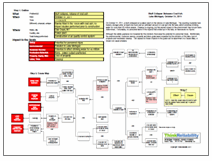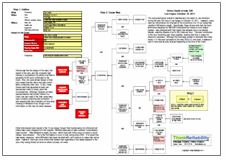Hockey fans were devastated when, on September 7, 2011, a Yak-42 plane carrying a Russian hockey team, including many former NHL players, crashed shortly after takeoff. A total of 44 people were killed, including 36 passengers and 8 crew members. One crew member survived the crash. This incident was the 7th fatal crash to occur in Russia since June, and resulted in the loss of the license of the company who operated the plane.
Now that the Russian air safety organization has released results from its investigation, we can map the details of the crash into a Cause Map, or visual root cause analysis. The Cause Map begins with the impacts to the goals. The deaths of the crew and passengers are an impact to the safety goal. The company losing its operating license can be considered an impact to the organizational goal. The damage to the plane is an impact to the property goal. All these impacts to the goals were caused by the plane crashing into a riverbank shortly after takeoff.
 We ask “Why” questions to add more detail to the map. It has been determined that the plane crashed because it had insufficient speed during takeoff, and the takeoff was not aborted. It is also possible that the pilot was attempting to emergency land in the river, and missed. The plane had insufficient speed during takeoff because the brake was pressed. Studies determined that a foot had to be placed on the brake pedal in order for the brake to be activated. Because of the force being used on the control column, it is likely that one of the pilots was attempting to push down using his foot as a brace. The pilots who were flying the plane were more familiar (and were being trained simultaneously on) another type of plane. This plane – the Yak-40 – has a foot rest where the Yak-42’s brake pedal is located. Normally pilots are only trained on one type of plane at a time to minimize this sort of confusion.
We ask “Why” questions to add more detail to the map. It has been determined that the plane crashed because it had insufficient speed during takeoff, and the takeoff was not aborted. It is also possible that the pilot was attempting to emergency land in the river, and missed. The plane had insufficient speed during takeoff because the brake was pressed. Studies determined that a foot had to be placed on the brake pedal in order for the brake to be activated. Because of the force being used on the control column, it is likely that one of the pilots was attempting to push down using his foot as a brace. The pilots who were flying the plane were more familiar (and were being trained simultaneously on) another type of plane. This plane – the Yak-40 – has a foot rest where the Yak-42’s brake pedal is located. Normally pilots are only trained on one type of plane at a time to minimize this sort of confusion.
In addition, at some point during takeoff, the engine was idled. This would normally indicate that takeoff is being aborted. Once the engine was brought back into service, it took some time to regain takeoff power – and the speed had already dropped. Aviation experts say that takeoff could have been aborted and the crash would have been avoided. However, it does not appear that an abort attempt was made. Flight recordings indicate confusion and a lack of effective communication in the cockpit. Prior to the engine being idled, one of the pilots pushed the control stick forward, after which it was pulled back to resume takeoff. The crew on this plane had never trained together before which is fairly typical, and may be part of the reason for the recent poor safety record of planes in Russia. Additionally, the pilot had Phenobarbital in his system, which is known to slow reaction time. Recommendations to attempt to improve the safety of small planes of regional carriers in Russia have been under consideration with the recent rash of crashes. However, the loss of many popular hockey players may increase the urging to implement these solutions.
To view the Outline and Cause Map, please click “Download PDF” above. Or click here to read more.









